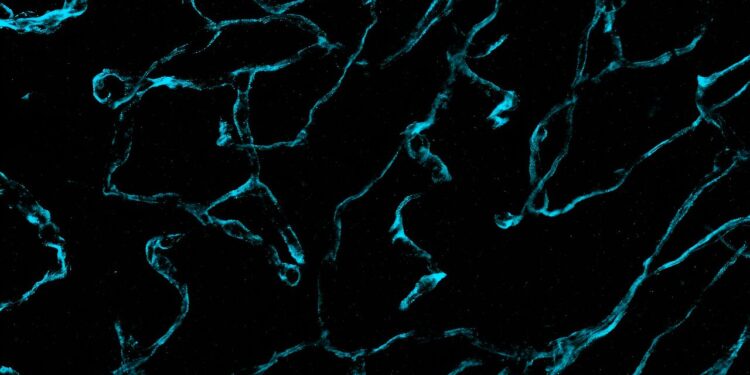Credit: Scientific translational medicine (2024). DOI: 10.1126/scitranslmed.abo0049
Researchers from Brigham and Women’s Hospital and the Massachusetts Institute of Technology (MIT) have revealed unprecedentedly precise images of brain cancer tissue using a new microscopy technology called decrowding pathology. (dExPath). Their findings, published in Scientific translational medicineprovide new insights into the development of brain cancer, with potential implications for advancing the diagnosis and treatment of aggressive neurological diseases.
“In the past, we relied on expensive super-resolution microscopes that only very well-funded laboratories could afford, which required specialized training to use, and which were often impractical for high-throughput analyzes of brain tissue at the molecular level,” said Pablo Valdes, MD, PhD, a former neurosurgery resident at the Brigham and lead author of the study. “This technology brings reliable, super-resolution imaging to the clinic, allowing scientists to study neurological diseases at a nanoscale level never before achieved on conventional clinical samples with conventional microscopes.”
Researchers previously relied on expensive, very high-resolution microscopes to image the nanoscale structures of brain cells and tissues, and even with the most advanced technology, they often struggled to effectively capture these structures at the nanoscale.
Ed Boyden, Ph.D., the Y. Eva Tan Professor of Neurotechnology at MIT and co-senior author of this study, began to address this problem by marking tissues and then chemically modifying them to allow uniform physical expansion of the tissues. . However, this expansion technology was far from perfect. Relying on enzymes called proteases to break down tissues, scientists found that this chemical treatment with enzymes destroyed proteins before they could be analyzed, leaving behind only a skeleton of the original structure, retaining only the labels.
Working together, Boyden and E. Antonio Chiocca, MD, Ph.D., chair of neurosurgery at Brigham and Women’s Hospital and co-senior author of this study, mentored Valdes during his training as a neurosurgeon scientist, to develop new chemistries with dExPath. to address the limitations of the original expansion technology.
Their new technology chemically modifies tissues by coating them in a gel and “softening” them with a special chemical treatment that separates the protein structures without destroying them and allows the tissues to grow. This provided exciting results for researchers at MIT and Brigham, who routinely use commercially available antibodies to bind to and illuminate biomarkers present in a sample.
However, antibodies are bulky and often cannot easily penetrate cellular structures to reach their target. Now, by separating proteins with dExPath, these same antibodies used for staining can penetrate spaces to bind proteins in tissues that were not accessible before expansion, highlighting nanometer-sized structures or even cell populations that were previously hidden.
“The human brain has several safeguards to protect against pathogens and environmental toxins. But these make studying brain activity difficult. It can be a bit like driving a car through mud and ditches “We cannot access certain cellular structures in the brain because of barriers,” said E. Antonio Chiocca, MD, Ph.D., chair of the Department of Neurosurgery at the Brigham. “This is one of the reasons why this new technology could change practices so much. If we can take more detailed and precise images of brain tissue, we can identify more biomarkers and be better equipped to diagnose and treat aggressive brain diseases.”
To validate the effectiveness of dExPath, Boyden and Chiocca’s team applied the technology to healthy human brain tissue, high- and low-grade cancerous brain tissue, and brain tissue affected by neurodegenerative diseases, including Alzheimer’s and Parkinson’s diseases. The investigators stained the tissues for brain- and disease-specific biomarkers and captured images before and after expanding the samples with dExPath.
The results revealed uniform and consistent expansion of the tissue without distortion, enabling precise analysis of protein structures. Additionally, dExPath effectively removed fluorescent signals in brain tissue called lipofuscin, which makes it very difficult to image subcellular structures in brain tissue, thereby improving image quality. Additionally, dExPath provided more powerful fluorescent signals for enhanced labeling as well as simultaneous labeling of up to 16 biomarkers in the same tissue sample. Notably, dExPath imaging revealed that tumors previously classified as “low grade” contained more aggressive features and cell populations, suggesting that the tumor could become much more dangerous than expected.
Although promising, dExPath requires validation on larger sample sizes before it can contribute to the diagnosis of neurological diseases such as brain cancer. Valdes emphasizes that while her team is still in its early stages, she aspires for this technology to eventually serve as a diagnostic tool, improving patient outcomes.
“We hope that with this technology we can better understand at the nanoscale the complex functioning of brain tumors and their interactions with the nervous system without relying on exorbitant laboratory equipment,” said Valdes, now an assistant professor of neurosurgery. and Jenny. Sealy Distinguished Chair in Neuroscience at the University of Texas Medical Branch.
“The accessibility of dExPath will enable super-resolution imaging to understand biological processing at the nano-level in human tissues in neuro-oncology and neurological diseases such as Alzheimer’s and Parkinson’s, and could even one day improve diagnostic strategies and patient outcomes. “
The authors are Pablo Valdes (BWH and MIT), Chih-Chieh (Jay) Yu, Jenna Aronson, Debarati Ghosh, Yongxin Zhao, Bobae An (MIT), Joshua D. Bernstock (BWH and MIT), Deepak Bhere (BWH), Michelle M. Felicella, Mariano S. Viapiano, Khalid Shah (BWH), and co-corresponding lead authors E. Antonio Chiocca and Edward S. Boyden.
More information:
Pablo Valdes et al, Enhanced immunostaining of nanostructures and cells in human brain samples through expansion-mediated protein uncoating, Scientific translational medicine (2024). DOI: 10.1126/scitranslmed.abo0049
Provided by Brigham and Women’s Hospital
Quote: A new way to visualize brain cancer at the nanoscale (January 31, 2024) retrieved January 31, 2024 from
This document is subject to copyright. Except for fair use for private study or research purposes, no part may be reproduced without written permission. The content is provided for information only.



